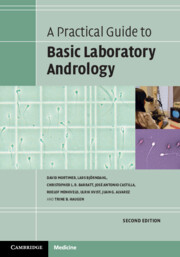Book contents
- A Practical Guide to Basic Laboratory Andrology
- A Practical Guide to Basic Laboratory Andrology
- Copyright page
- Contents
- Abbreviations
- Chapter 1 Introduction
- Chapter 2 Basic Physiology
- Chapter 3 Basic Semen Examination
- Chapter 4 Extended Semen Analysis
- Chapter 5 Sperm DNA
- Chapter 6 Computer-Aided Sperm Analysis
- Chapter 7 Sperm Function Tests
- Chapter 8 Tests of Sperm-Cervical Mucus Interaction
- Chapter 9 Sperm Preparation
- Chapter 10 Sperm Cryopreservation
- Chapter 11 Preparation of Surgically Retrieved Spermatozoa
- Chapter 12 Quality Management and Accreditation
- Chapter 13 Risk Management
- Chapter 14 Reproductive Toxicology
- Chapter 15 Andrology Laboratory Safety
- Book part
- Index
- References
Chapter 4 - Extended Semen Analysis
Published online by Cambridge University Press: 16 February 2022
- A Practical Guide to Basic Laboratory Andrology
- A Practical Guide to Basic Laboratory Andrology
- Copyright page
- Contents
- Abbreviations
- Chapter 1 Introduction
- Chapter 2 Basic Physiology
- Chapter 3 Basic Semen Examination
- Chapter 4 Extended Semen Analysis
- Chapter 5 Sperm DNA
- Chapter 6 Computer-Aided Sperm Analysis
- Chapter 7 Sperm Function Tests
- Chapter 8 Tests of Sperm-Cervical Mucus Interaction
- Chapter 9 Sperm Preparation
- Chapter 10 Sperm Cryopreservation
- Chapter 11 Preparation of Surgically Retrieved Spermatozoa
- Chapter 12 Quality Management and Accreditation
- Chapter 13 Risk Management
- Chapter 14 Reproductive Toxicology
- Chapter 15 Andrology Laboratory Safety
- Book part
- Index
- References
Summary
Provides methods for a range of common additional assessments on semen that are structured as standard operating procedures (SOPs) for easy use at the bench. Methods are focussed on objectivity, robustness, standardized reporting, controlling the risk of errors, and minimizing measurement uncertainty. Includes anti-sperm antobodies (direct and indirect MAR test), immunocytochemical staining of leukocytes, meaaurement of reactive oxygen species and seminal plasma redox state, and biochemical tests on the seminal plasma to evaluate acessory gland function (zinc for the prostate, frutose for the seminal vesicles and alpha-glusidase for the epidiymis) and investigate abnormalities of the sequence of ejaculation. There is also a discussion on the microbiological examination of semen,.
- Type
- Chapter
- Information
- A Practical Guide to Basic Laboratory Andrology , pp. 81 - 113Publisher: Cambridge University PressPrint publication year: 2022
References
- 1
- Cited by

